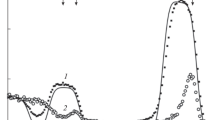Abstract
Thin-filmed dichalcogenides of transition metals, in particular, MoSe2, are considered as potentially active materials in the hydrogen evolution reaction, which can compete with expensive platinum. It has been established that the laser deposition technique ensures the formation of nanocomposite films containing a high density of Mo nanoparticles in the MoSe x shell. Deposition of Mo nanoparticles increase roughness and induce activation of a surface. This manifests itself in formation of “edge” sites in the MoSe x shell and on edges of the basis planes in MoSe x nanocrystals oriented normally to the film surface. In a 0.5 M H2SO4 solution, on carbon cathodes coated with MoSe x films, the hydrogen overvoltage dropped to −0.17 V and the current density doubled.
Similar content being viewed by others
References
A. B. Laursen, S. Kegnoes, S. Dahl, et al., Energy Environ. Sci. 5, 5577 (2012).
T. F. Jaramillo, K. P. Jorgensen, J. Bonde, et al., Science 317, 100 (2007).
L. T. L. Lee, J. He, B. Wang, et al., Sci. Rep. 4(4063), 1 (2014).
H. I. Karunadasa, E. Montalvo, Y. Sun, et al., Science 335, 698 (2012).
D. Le, T. B. Rawal, and T. S. Rahman, J. Phys. Chem. C 118, 5346 (2014).
H. Vrubel, T. Moehl, M. Gratzel, et al., Chem. Commun. 49, 8985 (2013).
V. Yu. Fominski, S. N. Grigoriev, A. G. Gnedovets, and R.I. Romanov, Tech. Phys. Lett. 39(3), 312 (2013).
V. Yu. Fominski, S. N. Grigoriev, A. G. Gnedovets, et al., Surf. Coat. Technol. 206, 5046 (2012).
S. N. Grigoriev, V. Yu. Fominski, R. I. Romanov, et al., Thin Solid Films 556, 35 (2014).
V. Yu. Fominski, R. I. Romanov, A. G. Gnedovets, and V. N. Nevolin, Tech. Phys. 55(10), 1509 (2010).
V. N. Nevolin, V. Yu. Fominski, A. G. Gnedovets, and R. I. Romanov, Tech. Phys. 54(1), 117 (2009).
D. Kong, H. Wang, and J. J. Cha, Nano Lett. 13, 1341 (2013).
C.-B. Ma, X. Qi, B. Chen, et al., Nanoscale 6, 5624 (2014).
Author information
Authors and Affiliations
Corresponding author
Additional information
Original Russian Text © V.Yu. Fominski, S.N. Grigoriev, R.I. Romanov, M.A. Volosova, 2015, published in Pis’ma v Zhurnal Tekhnicheskoi Fiziki, 2015, Vol. 41, No. 5, pp. 50–58.
Rights and permissions
About this article
Cite this article
Fominski, V.Y., Grigoriev, S.N., Romanov, R.I. et al. Nanostructured catalyst for hydrogen electrochemical reduction based on molybdenum diselenide thin films. Tech. Phys. Lett. 41, 231–234 (2015). https://doi.org/10.1134/S1063785015030050
Received:
Published:
Issue Date:
DOI: https://doi.org/10.1134/S1063785015030050



